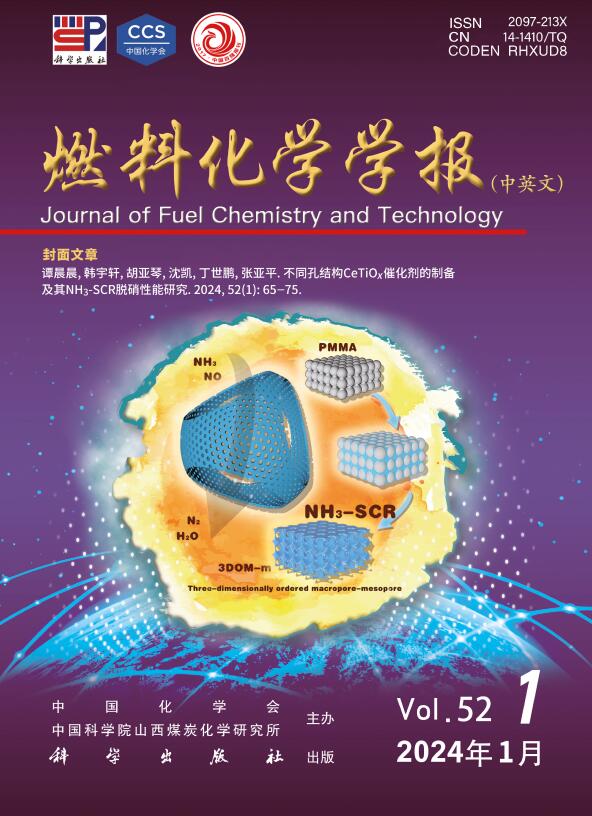pt改性FeZn催化剂提高常压CO2-FTS制备α-烯烃稳定性的研究
Q3 Energy
引用次数: 0
摘要
常压CO2-FTS合成α-烯烃具有安全、运行成本低、节省设备投资等优点。但该反应存在CO和CH4选择性高、催化剂稳定性差等问题。为了解决这些问题,设计并合成了Cu、Co、Ru和pt改性FeZn催化剂,用于常压CO2-FTS反应。结果表明,Pt的引入显著提高了CO2转化的稳定性,降低了副产物CO和CH4的选择性,促进了有价C2+烃产物的生成。在FeZn催化剂中掺入6% Pt时,CO2转化率从22.5%提高到27.3%,且在20 h内未出现明显失活现象,CO和CH4的平均选择性分别从93.1%和52.9%明显下降到80.0%和20.5%。特别是当H2/CO2比由3增加到7时,CO2转化率提高到48.6%,CO选择性急剧下降到24.0%,同时对C2+烃产物的选择性显著提高。更重要的是,对CH4的选择性进一步降低,约为13.1%,在C2 -C4烃馏分中,α-烯烃含量达到90%以上,对CO和CH4的选择性趋于稳定。XRD、H2- tpr、CO- tpd、CO2-TPD、H2- d2交换、TEM、Raman、XPS和MES表征结果表明,Pt的引入显著增强了CO的吸附和解离,以及H2的解离,从而促进了表面CO*的加氢和偶联形成C2+碳氢化合物,减少了碳沉积。值得一提的是,在FeZn催化剂中加入Pt消除了石墨碳的形成,降低了碳化铁纳米颗粒周围非晶碳层的厚度。此外,Pt提高了催化剂中Fe种的碳化能力,增加了FTS的活性相χ-Fe5C2的含量,减小了χ-Fe5C2颗粒的结晶尺寸。本文章由计算机程序翻译,如有差异,请以英文原文为准。
Study on the enhancement of stability in ambient pressure CO2-FTS for the production of α-olefins by Pt-modified FeZn catalysts
The CO2-FTS under ambient pressure for α-olefins synthesis offers advantages such as safety, lower operating cost, and saving equipment investment. However, the reaction has encountered challenges including high selectivity for CO and CH4, as well as poor catalyst stability. To address these issues, Cu, Co, Ru, and Pt-modified FeZn catalysts were designed and synthesized for the ambient pressure CO2-FTS reaction. The results show that the introduction of Pt significantly improves the stability of CO2 conversion, reducing the selectivity for by-products CO and CH4, and promoting the formation of valuable C2+ hydrocarbon products. When optimized content of 6% Pt was incorporated into the FeZn catalyst, the CO2 conversion rate increased from 22.5% to 27.3%, and no obvious deactivation was observed over 20 h. Correspondingly, the average selectivity for CO and CH4 decreased obviously from 93.1% and 52.9% to 80.0% and 20.5%, respectively. Especially, when the H2/CO2 ratio was increased from 3 to 7, CO2 conversion enhanced up to 48.6%, CO selectivity sharply decreased to 24.0%, and at the same time, the selectivity for C2+ hydrocarbon products increased noticeably. More importantly, the undesired selectivity to CH4 was further lower toward about 13.1%, high α-olefins content was achieved like 90%
in the C2−C4 hydrocarbon fraction, and the selectivity to CO and CH4 became stable. Characterization results from XRD, H2-TPR, CO-TPD, CO2-TPD, H2-D2 exchange, TEM, Raman, XPS and MES indicate that the introduction of Pt significantly enhances the adsorption and dissociation of CO, as well as the dissociation of H2, thus promoting the hydrogenation and coupling of surface CO* species to form C2+ hydrocarbons and reducing the carbon deposits. It should be mentioned that the addition of Pt into FeZn catalyst has eliminated the formation of graphite carbon and reduced the thickness of amorphous carbon layer around the iron carbide nanoparticles. Moreover, Pt improves the carbonization ability of Fe species in the catalyst, increases the content of the active phase χ-Fe5C2 for FTS, and decreases the crystaline size of χ-Fe5C2 particles.
求助全文
通过发布文献求助,成功后即可免费获取论文全文。
去求助
来源期刊

燃料化学学报
Chemical Engineering-Chemical Engineering (all)
CiteScore
2.80
自引率
0.00%
发文量
5825
期刊介绍:
Journal of Fuel Chemistry and Technology (Ranliao Huaxue Xuebao) is a Chinese Academy of Sciences(CAS) journal started in 1956, sponsored by the Chinese Chemical Society and the Institute of Coal Chemistry, Chinese Academy of Sciences(CAS). The journal is published bimonthly by Science Press in China and widely distributed in about 20 countries. Journal of Fuel Chemistry and Technology publishes reports of both basic and applied research in the chemistry and chemical engineering of many energy sources, including that involved in the nature, processing and utilization of coal, petroleum, oil shale, natural gas, biomass and synfuels, as well as related subjects of increasing interest such as C1 chemistry, pollutions control and new catalytic materials. Types of publications include original research articles, short communications, research notes and reviews. Both domestic and international contributors are welcome. Manuscripts written in Chinese or English will be accepted. Additional English titles, abstracts and key words should be included in Chinese manuscripts. All manuscripts are subject to critical review by the editorial committee, which is composed of about 10 foreign and 50 Chinese experts in fuel science. Journal of Fuel Chemistry and Technology has been a source of primary research work in fuel chemistry as a Chinese core scientific periodical.
 求助内容:
求助内容: 应助结果提醒方式:
应助结果提醒方式:


